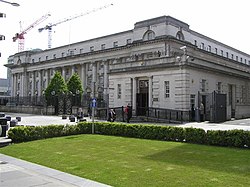Royal Courts of Justice, Belfast
| Royal Courts of Justice, Belfast | |
|---|---|
 Royal Courts of Justice, Belfast | |
| Location | Chichester Street, Belfast |
| Coordinates | 54°35′50″N 5°55′20″W / 54.59730°N 5.92218°W |
| Built | 1933 |
| Architect | Sir Richard Allison and James Grey West |
| Architectural style(s) | Neoclassical style |
| Website | justice-ni |
Listed Building – Grade A | |
| Official name | Royal Courts of Justice, Chichester Street, Belfast |
| Designated | 30 November 1988 |
| Reference no. | HB 26/50/180 |
The Royal Courts of Justice in Chichester Street, Belfast is the home of the Court of Judicature of Northern Ireland established under the Judicature (Northern Ireland) Act 1978. This comprises the Northern Ireland Court of Appeal, High Court of Northern Ireland and the Crown Court in Northern Ireland.[1] It is a Grade A listed building.[2]
History
[edit]Until 1920, the most senior courts in Ireland were in Dublin but under the Government of Ireland Act 1920, the British Government was required to establish a separate judicial system for Northern Ireland.[3]
The building, which was designed by Sir Richard Allison and James Grey West in the Neoclassical style, was built between 1928 and 1933.[4] The building was officially opened by the Governor of Northern Ireland, the Duke of Abercorn, in 1933.[5] The design involved a symmetrical main frontage with thirteen bays facing onto Chichester Street with the end bays slightly projected forward; the central section of three bays featured a deeply recessed portico flanked by four Corinthian order columns supporting an entablature; the centre window on the first floor was decorated with a carving depicting the Royal coat of arms.[2]
The building was targeted during the Troubles and was surrounded with large security screens.[4] It suffered from bomb damage in 1989[6] and again in January 1997 when the Irish Republican Army attacked the building resulting in one Royal Ulster Constabulary officer being injured.[7]
The Laganside Courts Complex, located to the north of the main building on the site of a former livestock market, was procured under a private finance initiative contract in 1999.[8][9] The building, which was designed by Hurd Rolland and built by a joint venture of Turkington Construction and Karl Group at a cost of £50 million, was completed in 2002.[10] The complex, which created six new courtrooms for the Crown Court, six new magistrates courts and four new county courts, replaced the Newtownabbey Courthouse, the Belfast magistrates' court and the Crumlin Road Courthouse.[11]
See also
[edit]- Northern Ireland Courts and Tribunals Service
- Royal Courts of Justice, London
- Parliament House, Edinburgh
References
[edit]- ^ Northern Ireland Courts and Tribunals Service, Heritage Tour - Royal Courts of Justice (Belfast, 6 October 2010) (accessed: 6 June 2011)
- ^ a b "Royal Courts of Justice, Chichester Street, Belfast". Department for Communities. Retrieved 23 November 2019.
- ^ "Government of Ireland Act 1920 [as enacted]". legislation.gov.uk. 23 December 1920. Retrieved 5 November 2020.
- ^ a b "1933 – Royal Courts of Justice, Belfast". Archiseek. Retrieved 5 November 2020.
- ^ Gillian McIntosh (1999), The Force of Culture: Unionist Identities in Contemporary Ireland, Cork University Press
- ^ "Blast rocks Belfast court building". CNN. 6 January 1997. Archived from the original on 2 November 2019. Retrieved 2 November 2019.
- ^ "A Chronology of the Conflict". University of Ulster. 1997. Retrieved 5 November 2020.
- ^ Scott L. Greer (2005), Territorial Politics and Health Policy: UK Health Policy in Comparative Perspective, Manchester University Press, ISBN 9780719069505
- ^ "Royal Courts of Justice and Laganside Courts". In Your Pocket. Retrieved 5 November 2020.
- ^ "Laganside Court". Future Belfast. Retrieved 5 November 2020.
- ^ "Laganside Courts Complex". Culture Northern Ireland. Retrieved 5 November 2020.
External links
[edit]


